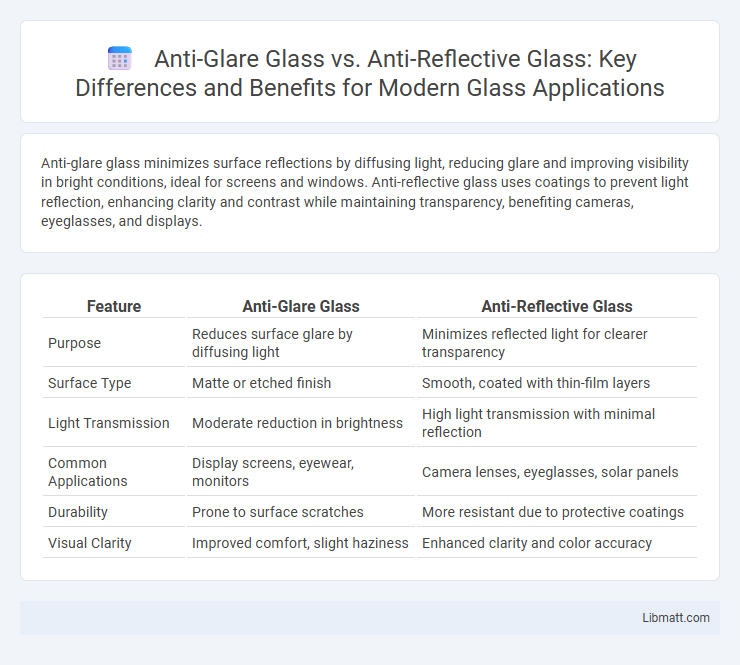Anti-glare glass minimizes surface reflections by diffusing light, reducing glare and improving visibility in bright conditions, ideal for screens and windows. Anti-reflective glass uses coatings to prevent light reflection, enhancing clarity and contrast while maintaining transparency, benefiting cameras, eyeglasses, and displays.
Table of Comparison
| Feature | Anti-Glare Glass | Anti-Reflective Glass |
|---|---|---|
| Purpose | Reduces surface glare by diffusing light | Minimizes reflected light for clearer transparency |
| Surface Type | Matte or etched finish | Smooth, coated with thin-film layers |
| Light Transmission | Moderate reduction in brightness | High light transmission with minimal reflection |
| Common Applications | Display screens, eyewear, monitors | Camera lenses, eyeglasses, solar panels |
| Durability | Prone to surface scratches | More resistant due to protective coatings |
| Visual Clarity | Improved comfort, slight haziness | Enhanced clarity and color accuracy |
Introduction to Anti-Glare and Anti-Reflective Glass
Anti-glare glass reduces surface reflections by diffusing light, improving visibility in bright conditions, while anti-reflective glass minimizes light reflection through thin-film coatings, enhancing clarity and contrast. Both technologies serve to optimize viewing experiences but target different optical challenges; your choice depends on whether you prioritize glare reduction or maximum transparency. Understanding the distinct mechanisms of anti-glare and anti-reflective glass helps you select the best solution for screens, windows, or eyewear applications.
How Anti-Glare Glass Works
Anti-glare glass works by diffusing light across its surface to reduce glare and harsh reflections, enhancing visual comfort without significantly altering the clarity of images seen through it. The textured or matte finish scatters incoming light rays, minimizing the intensity of direct reflections from bright sources such as sunlight or artificial lighting. This technology is commonly used in electronic displays, eyeglasses, and automotive windows to improve visibility and reduce eye strain under bright conditions.
How Anti-Reflective Glass Works
Anti-reflective glass reduces surface reflections by using multiple thin optical coatings that create destructive interference to cancel reflected light waves. This technology enhances light transmission through the glass, improving visual clarity and reducing glare without darkening the viewed image. Commonly applied in lenses, screens, and windows, anti-reflective coatings optimize visibility and reduce eye strain in various lighting conditions.
Key Differences Between Anti-Glare and Anti-Reflective Glass
Anti-glare glass features a matte surface that diffuses light to reduce glare, making screens and displays easier to view in bright environments. Anti-reflective glass employs a thin coating designed to minimize reflections by enhancing light transmission through the glass, improving clarity and contrast. While anti-glare reduces surface reflections through texture, anti-reflective glass works by altering light behavior at the surface for superior image sharpness.
Optical Clarity Comparisons
Anti-glare glass reduces surface light reflection by etching or coating the glass, diffusing incoming light and minimizing glare but can slightly reduce optical clarity due to this diffusion. Anti-reflective (AR) glass employs multi-layer coatings to almost eliminate reflections, significantly enhancing optical clarity and light transmission through the glass. When comparing optical clarity, AR glass offers a clearer, sharper viewing experience, while anti-glare glass prioritizes reducing glare at the expense of some clarity.
Durability and Maintenance
Anti-glare glass features a matte surface that reduces glare by diffusing light, offering high durability with minimal risk of scratches, making it low-maintenance and suitable for environments prone to wear. Anti-reflective glass utilizes a multi-layer coating to minimize reflections, enhancing clarity but requiring careful cleaning to maintain its effectiveness and prevent damage to the delicate coating. Your choice should consider the balance between long-lasting durability and the level of upkeep you're prepared to manage.
Best Use Cases for Anti-Glare Glass
Anti-glare glass is ideal for environments with strong direct lighting, such as office spaces, computer screens, and smartphone displays, where reducing surface glare improves visibility and reduces eye strain. This glass features a matte finish that diffuses reflected light, making it suitable for retail displays, tabletops, and digital signage in brightly lit areas. Its effectiveness in minimizing mirror-like reflections enhances user comfort and productivity in both commercial and residential applications.
Best Use Cases for Anti-Reflective Glass
Anti-reflective glass is ideal for applications requiring enhanced visual clarity and reduced glare, such as camera lenses, eyeglasses, display screens, and solar panels. Its specialized coatings minimize light reflections, improving image quality and user comfort in bright environments. If you need to optimize visibility and reduce eye strain in your devices or eyewear, anti-reflective glass is the preferred choice.
Cost Considerations and Value
Anti-glare glass typically costs less than anti-reflective glass due to simpler manufacturing processes and materials. While anti-reflective coatings offer superior clarity and reduce reflections more effectively, they require higher upfront investment but can enhance visual comfort and reduce eye strain in the long term. Your choice depends on balancing initial expense with the value of improved visibility and reduced glare in specific environments.
Choosing the Right Glass for Your Needs
Anti-glare glass reduces surface reflections by using a textured coating that diffuses light, making it ideal for environments with bright or direct lighting. Anti-reflective glass employs a multilayer coating to minimize reflected light and enhance clarity, perfect for display cases, screens, or windows where visibility and color accuracy matter. Choosing the right glass for your needs depends on whether you prioritize reducing diffuse glare or enhancing transparency and light transmission.
Anti-glare glass vs anti-reflective glass Infographic

 libmatt.com
libmatt.com